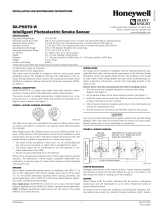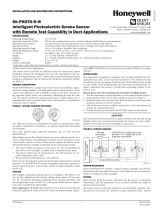Page is loading ...

N200-06-00 1 I56-057-00R
© 2000 Notifier
J200-05-00 1 I56-1898-003R
Johnson Controls Inc., 507 E. Michigan St., Milwaukee, WI 53201
This sensor must be installed in compliance with the control panel system installation manual. The installation must meet the requirements of the Authority
Having Jurisdiction (AHJ). Sensors offer maximum performance when installed in compliance with the National Fire Protection Association (NFPA); see NFPA
72..
GENERAL DESCRIPTION
Model 7351J is a plug-in type smoke sensor that uses a laser based photoelectronic sensing chamber. The sensor uses analog-addressable communications
to transmit smoke density and other information to the control panel.
Two LEDs on each sensor light to provide a local, visible sensor indication. Remote LED annunciator capability is available as an optional accessory (Part No.
RA400Z).
Johnson Controls panels offer different features sets across different models. As a result, certain features of the product may be available on some control
panels, but not on others. The possible features available in the product, if supported by the control unit are:
1. The panel controls the LED operation on the sensor. Operational modes are RED blink, RED continuous, GREEN blink, and off.
2. The remote output may be synchronized to the LED operation or controlled independent of the LEDs.
Please refer to the operation manual for the UL listed control unit for specific operation of the 7351J.
SPECIFICATIONS
Operating Voltage
Range: 15 to 32 VDC
Standby Current: 330µA @ 24 VDC (one
communication every 5 seconds
with LED blink enabled)
Max. Alarm Current (LED on): 6.5 mA @ 24 VDC
Operating Humidity Range: 10% to 93% Relative Humidity,
noncondensing
Operating Temperature Range: 0°C to 38°C (32°F to 100°F); U.S.
–10°C to 50°C (14°F to 122°F);
Europe
Height: 1.7 inches (43 mm) installed
in B210LPJ Base
Diameter: 6.1 inches (155 mm) installed
in B210LPJ Base
4.1 inches (104 mm) installed
in B501J Base
Weight: 5.0 oz. (142 g)
SPACING
Johnson Controls recommends spacing sensors in compliance with NFPA 72. In low air flow applica-
tions with smooth ceilings, space sensors 30 feet apart. For specific information regarding sensor
spacing, placement, and special applications, refer to NFPA 72 or Johnson Controls System Smoke
Detector Application Guide, available at no charge from Johnson Controls.
WIRING INSTRUCTIONS
All wiring must be installed in compliance with the National Electrical Code, applicable local codes,
and any special requirements of the Authority Having Jurisdiction. Proper wire gauges should be
used. The installation wires should be color-coded to limit wiring mistakes and ease system trouble-
shooting. Improper connections will prevent a system from responding properly in the event of a fire.
Disconnect power from the communication line before installing sensors.
All wiring must conform to applicable local codes, ordinances, and regulations.
1. Wire the sensor base (supplied separately) per the wiring diagram (Figure 1).
2. Set the desired address on the sensor address switches.
NOTE: Some panels support extended addressing. In order to set the sensor above address 99
on compatible systems, carefully remove the stop on the upper rotary switch with thumb as
shown in Figure 2.
3. Install the sensor into the sensor base. Push the sensor into the base while turning it clockwise
to secure it in place.
4. After all sensors have been installed, apply power to the control unit and activate the commu-
nication line.
5. Test the sensor(s) as described in the TESTING section of this manual.
CAUTION
Dust covers provide limited protection against airborne dust particles during shipping. Dust covers
must be removed before the sensors can sense smoke. Remove sensors prior to heavy remodeling
or construction.
3
2
1
3
2
1
+
-
-
+
+-
REMOTE
ANNUNCIATOR
UL LISTED COMPATIBLE
CONTROL PANEL
OPTIONAL RETURN LOOP
DO NOT LOOP WIRE
UNDER TERMINAL 1 OR 2.
BREAK WIRE RUN TO
PROVIDE SUPERVISION
OF CONNECTION.
C0147-00
Figure 1. Wiring Diagram
TENS ONES
9
10
11
12
13
14
15
8
7
6
5
4
3
2
1
0
9
8
7
6
5
4
3
2
1
0
D
N
T
N
I
A
P
T
O
O
LED STATUS
INDICATORS
TEST
MAGNET
PAINTED
SURFACE
PAINTED
SURFACE
TEST
MAGNET
MAGNET TEST
MARKER
C0413-00
Figure 3.
Do not loop wire under terminal
1 or 2. Break wire to provide
supervision of connection.
CAUTION
Figure 2. Rotary Address Switches
7351J Intelligent Laser Smoke Sensor
Installation and Maintenance Instructions
C0162-00
I56-1898-003R

TESTING
Before testing, notify the proper authorities that the system is undergoing maintenance, and will temporarily be out of service. Disable the system to prevent
unwanted alarms.
All sensors must be tested after installation and periodically thereafter. Testing methods must satisfy the Authority Having Jurisdiction (AHJ). Sensors offer
maximum performance when tested and maintained in compliance with NFPA 72. The sensor can be tested in the following ways:
A. Functional: Magnet Test (P/N M02-04-01 or M02-09-00)
This sensor can be functionally tested with a test magnet. The test magnet electronically simulates smoke in the sensing chamber, testing the sensor
electronics and connections to the control panel.
1. Hold the test magnet in the magnet test area as shown.
2. The sensor should alarm the panel.
Two LEDs on the sensor are controlled by the panel to indicate sensor status. Coded signals, transmitted from the panel, can cause the LEDs to blink, latch
on, or latch off. Refer to the control panel technical documentation for sensor LED status operation and expected delay to alarm.
B. Smoke Entry: Aerosol Generator (Gemini 501)
The Gemini model 501 aerosol generator can be used for smoke entry testing. Set the generator to represent 4%/ft. to 5%/ft. obscuration as described in
the Gemini 501 manual. Using the bowl shaped applicator, apply aerosol until the panel alarms.
A sensor that fails any of these tests should be cleaned as described under CLEANING, and retested. If the sensor fails after cleaning, it must be replaced and
returned for repair.
When testing is complete, restore the system to normal operation and notify the proper authorities that the system is back in operation.
CLEANING
It is recommended that the detector be removed from its mounting base to facilitate cleaning. The detector is cleaned as follows:
NOTE: Before removing the detector, notify the proper authorities that the smoke detector system is
undergoing maintenance and will be temporarily out of service. Disable the zone or system
undergoing maintenance to prevent unwanted alarms.
1. Remove the detector cover by prying away the four side tabs with a small-bladed screwdriver, and then
pulling the cover from the base.
2. Vacuum the screen carefully without removing it. If further cleaning is required continue with Step 3,
otherwise skip to Step 7.
3. Remove the screen assembly/chamber cover by pulling it straight out (see Figure 4).
4. Clean the chamber by vacuuming or blowing out dust and particles.
5. Replace the sensing chamber cover, aligning the arrow on the top with arrow on the printed circuit
board.
6. To replace the screen, place it over the chamber assembly, turning it until it snaps into place.
7. Replace the cover using the LEDs to align the cover and then gently pushing it until it locks into place.
8. Reinstall the detector.
9. Test the detector as described in TESTING.
10. Reconnect disabled circuits.
11. Notify the proper authorities that the system is back on line.
LASER SAFETY INFORMATION
This smoke detector does not produce any hazardous laser radiation and is certified as a Class 1 laser
product under the U.S. Department of Health and Human Services (DHHS) Radiation Performance Standard
according to the Radiation Control for Health and Safety Act of 1968.
Any radiation emitted inside the smoke detector is completely within the protective housings and external
covers. The laser beam cannot escape from the detector during any phase of operation.
The Center of Devices and Radiological Health (CDRH) of the U.S. Food and Drug Administration implemented regulations for laser products on August 2, 1976.
These regulations apply to laser products manufactured after August 1, 1976. Compliance is mandatory for products marketed in the United States.
CAUTION
Use of controls, adjustments, or performance of procedures other than those specified in this manual may result in hazardous radiation exposure.
SPECIAL NOTE REGARDING SMOKE DETECTOR GUARDS
Smoke detectors are not to be used with detector guards unless the combination has been evaluated and found suitable for that purpose.
SENSOR COVER
COVER REMOVAL TABS
SCREEN ASSEMBLY
SENSING
CHAMBER
J200-05-00 2 I56-1898-003R
© 2008 Johnson Controls
C0170-00
Figure 4.
FCC Statement
This device complies with part 15 of the FCC Rules. Operation is subject to the following two conditions: (1) This device may not cause harmful inter-
ference, and (2) this device must accept any interference received, including interference that may cause undesired operation.
Note: This equipment has been tested and found to comply with the limits for a Class A digital device, pursuant to Part 15 of the FCC Rules. These
limits are designed to provide reasonable protection against harmful interference when the equipment is operated in a commercial environment. This
equipment generates, uses and can radiate radio frequency energy and, if not installed and used in accordance with the instruction manual, may
cause harmful interference to radio communications. Operation of this equipment in a residential area is likely to cause harmful interference in which
case the user will be required to correct the interference at his own expense.
Please refer to insert for the Limitations of Fire Alarm Systems
/


